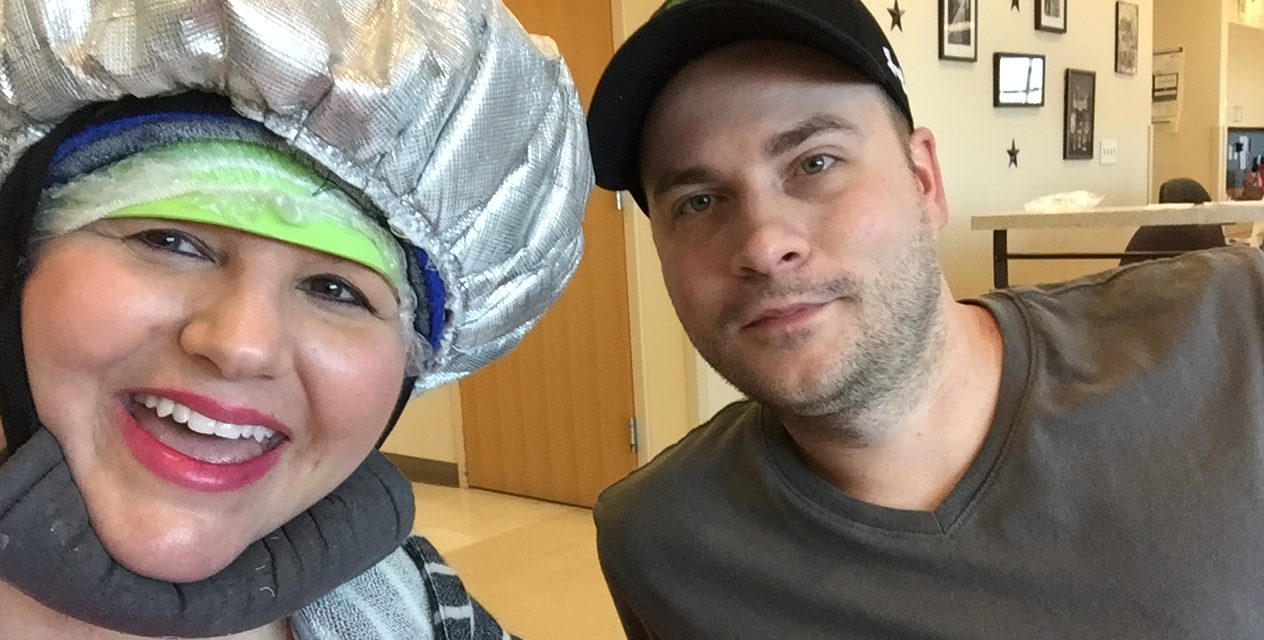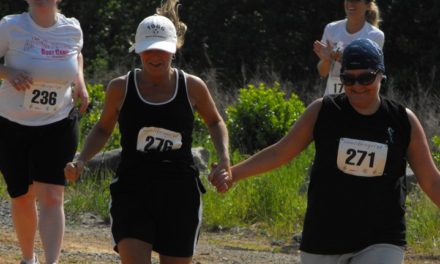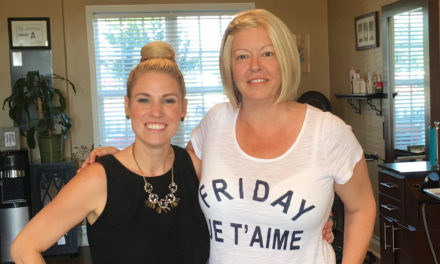Lisa Ferrand is a breast cancer survivor who used cold cap therapy (CCT) to successfully decrease hair loss during chemotherapy. She is such a believer in the process, she created her own company, WarriorCaps.com, to help more women learn about and access CCT affordably.
While I chose not to try CCT, I’m excited to share Lisa’s story with you. I hope you enjoy our Q&A! You can read more about the science behind CCT here: Does cold cap therapy help maintain hair during chemo?
Sherry: Thank you so much for taking the time to help SherryStrong.org readers understand how cold cap therapy can work! How time consuming is the process?
Lisa: Very. The exact timing depends on your chemo regimen. I wore the caps for 50 minutes before chemo started during my premeds, during chemo (which for me was a two-hour infusion) and for four hours after chemo. The goal is to keep the hair follicles frozen during the peak strength of the chemo. Some chemo combination studies show you can wear the cap for less time at the end, but four hours has been shown to work.
 Sherry: How did you find the energy?
Sherry: How did you find the energy?
Lisa: As a patient, it didn’t take a lot of energy on my part to wear them, because the patient can’t change the caps herself. My job was to sit there while other people did the work. It’s truly a mind game, but once you’re committed, it isn’t that difficult. For the last four hours, I wore the cap at home. There were times I would sleep through most of the 4 hours while my capper did the work. I wore the caps more than 100 hours total during my 16 chemotherapy sessions.
Sherry: What should a potential “capper” understand about the responsibility?
Lisa: They need to commit to helping the patient during the entire chemotherapy session and then for four hours after. It is a long day. They will be handling very cold caps (-31 degrees C) and have the responsibility to ensure the temperature is correct, the cap is pliable, placement on the patient’s head is accurate and the straps are adjusted to ensure a tight fit. This all needs to be done as quickly as possible. They will also be responsible for timing to ensure the cap is changed every 25 minutes. It is a big job, but it is doable with a friend or family member. It would be GREAT if the same person could be the capper for each session for consistency, but with proper training, anyone can do the job.
Sherry: Is there something you encountered that no one warned you about?
Lisa: Not directly in regards to the caps, but there were some emotional side effects. Because I “looked normal”(by still having my hair), sometimes people forgot I was going through a really tough battle. It is so ingrained in people that cancer patients have no hair, so when a cancer patient has hair, sometimes that gets lost on people. Of course, that’s the goal of cold caps to have life as normal, but sometimes I just really needed a hug and to be able to cry for just a minute, let my guard down and be vulnerable.
More: Can we have a moment of silence for our hair, please?
Sherry: What advice do you have? Any dos and don’ts?
Lisa: Caps add to an already emotional and physical time in your life. There are still emotions I went through when my hair went through shedding periods I’m sure were similar to those who lost all their hair. Instead of feeling some control by cutting your hair before chemo starts and you begin to lose your hair, a patient who chooses to try cold caps has to take the wait-and-see approach. I think I held my breath until around chemo session number 10, and then I was like, “Okay, we’ve got this.” You also have to accept there are absolutely no guarantees.
You also must have a strong support system or have the ability to pay someone to be a “capper” and be with you during every chemo session. I was very blessed my family was there through 16 rounds -the majority of the time, my brother.
Finally, when choosing the company you are going to rent from make sure they are responsive to your questions and you feel comfortable with them. I spoke to three companies before I made a decision.
Sherry: Thanks so much for your time, Lisa!
So, how awesome is Lisa’s brother?
When I found out Lisa’s brother, Jeff Boone (now Chief Operating Officer for Warrior Caps), had helped her through most of her “capping,” I had to get his take on the whole thing. “To be honest, I thought she was crazy to do the caps,” Jeff said. “I didn’t understand it and I just wanted the cancer out of my sister. But I saw how important it was to her to keep her hair so that’s what we did. She wore those caps for over 100 hours at -31 degrees. “Watching her go through treatment and be able to continue on with life like nothing was wrong — it was definitely worth it. I don’t think she would have had the same attitude without hair. It would have been harder on her.” Jeff said the process is easy, it’s just time-consuming. He often worried, “If I don’t secure the caps quickly enough or tight enough, will that be why Lisa loses her hair?”
Major sibling bond
Lisa’s take is simple: “I would not have been able to save my hair without him, period,” she said. “Being single and going through cancer isn’t fun. It definitely brought us closer.”
When Lisa decided to record one of her capping sessions, Jeff fell ill and couldn’t be there. “I was hysterical when they told me he couldn’t be there… . I actually took pictures of us when we were kids with me to the chemo infusion because I needed him with me.
“I had always been there to take care of him and now the roles were reversed. He took care of me and I know how hard that was for him. He has never been able to stand seeing me hurt, to watch me go through that I can’t imagine what it did to him.
“It would not have been his fault if I lost my hair,” she said. “We knew there were absolutely no guarantees, and I was on a tough hair regimen.” But now that Lisa has begun her own company dedicated to bringing cold cap therapy to women who might not otherwise have access, she understands Jeff’s worries. “We had a warrior start her chemo on Monday and I am more worried about her hair then I was about my own,” she said. “ You just want it to work so bad.”
For more information about Lisa’s work, visit www.WarriorCaps.com.





